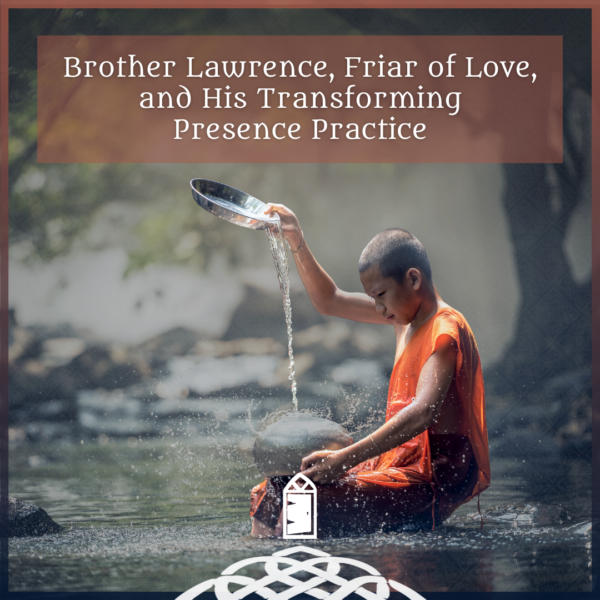This week we are featuring one of our Hildy Tails. This series of essays were composed last year for our Sustainers Circle. They were dictated to John by the Abbey’s mascot, Hildy the Monk-ey. Hildy is a bit of a free spirit who likes to entertain and doesn’t normally feel constrained by conventional story structure . . . or grammar, in general. She lives by the motto that “all stories are true; some actually happened.” We wanted to share them with you, our wider Abbey community, to give you a small monkey-sized, humorous perspective on some biblical passages and stories of the saints.
Greetings, fellow monks and pilgrims!
It’s me, Hildy, coming at ye with another story of odd religious characters and stories. And if you’ve noticed from the title to today’s rambling reflection (that’s how John describes these, and even though I think he was taking a dig at my storytelling skills, I kinda like it as a description of my personal style . . . speaking of which, where was I?) today’s rambling reflection doesn’t come from the Bible (not directly, but certainly figures inspired by the Bible), nor of just one character.
These are stories of saints, a special subsection of saint. It’s not an exhaustive list, as delving too much farther down this particular rabbit hole WOULD be exhausting (emotionally speaking). It’s kinda sad that it exists at all, but here we are: holy weirdness. And just in time for St. Valentine’s Day . . . where we’ve somehow turned a holy man’s letters from prison into a high-stakes game of commercialized romance. But don’t worry; I won’t be talking about him today. It’s just that the heavy-handed theme of romantic love that gets constantly thrown at us in February inspired this particular rant . . . REFLECTION! (Reflective rant? Ranting reflection? Did I mention rambling? Anyhoo . . .)
Today’s story is the story of three different female saints (a special, often ignored subsection of saints in and of itself). These three women share a lot in common beyond their canonization. They are strong-minded and independent women in a time and place that actively (and as you’ll soon read) often harshly discouraged both.
We’ll start with the most famous: St. Brigid, the Mary of the Gaels. Dear, beloved Irish Brigid was a busy woman, between all the praying and caring for the poor and building a monastery, that she had not time (and perhaps no interest) in romance. So when a young nobleman tries to woo her. She begins by being polite. (She’s not a saint for nuthin’.) But when that doesn’t work, she asks for God’s help getting rid of this pesky . . . I was about to say “suitor,” but stalker is a FAR more apt description. Anyway, God “helps” Brigid by giving her a pox on half her face. (There are some different versions of events, but this is the one I remember Ma telling us like it was a perfectly normal thing to happen.) Luckily the man (Or should I say “shallow, vain boy”?) is grossed out and gives up on Brigid. And luckier still (they do say we Irish are lucky), Brigid is healed of the pox after the would-be suitor leaves.
In a similar story (like I said, there’s more than just three), St. Wilgefortis can’t shake a man who refuses to take a simple “no” for an answer. (I realize there were a lot less people back then, but was Wilgefortis THAT much of a catch that he was pressing so hard? Be a gracious loser and move on. Have a little respect for yourself AND for the person who’s made it clear that they don’t like you in that way. It’s sad, but life is full of sadness and dwelling on this is only making it worse for everyone.) Anyhoo . . . Wilgefortis, being a good and saintly woman like Brigid, prays for God’s help. And help does come. Fortunately for Wilgefortis, it’s not the pox. It’s a beard. A beard! She grows a full beard. (Now don’t get me wrong, as a monkey, covered in fur, I think a beard is a very attractive look on just about anyone. But this is one of God’s weirder solutions to a problem.) But this guy can’t see the beauty in a lovely bit of facial fur (he probably had a beard himself and was perhaps a bit jealous that Wilgefortis’ was longer and lusher than his), or see past it to the beauty beneath, and so he splits. But unlike Brigid’s disfigurement, this story doesn’t end here. You see, Wilgefortis’ father REALLY wanted this guy to be his son-in-law and was REALLY not happy with his daughter’s refusal to cooperate. He blamed this new-fangled-Christian religion she was following and so came up with what he thought was a fitting punishment. He crucified her! His own daughter, murdered on a cross. It does mean there are religious statues of a beautiful, bearded, woman nailed to a cross in churches across Europe. But still . . . this is NOT what is meant by suffering for one’s art. And all because a couple of men wouldn’t respect Wilgefortis’ simple wish to be left alone to live her life for God as she saw fit.
I can hear what you’re thinking. “One is a tragedy. And two is a tragic coincidence. But is it a trend?” Well, what about a third story, from another (lesser known) Irish saint. Saint Dearbhla of Belmullet (yes, she is one of the Dancing Monk icons) literally ran away from a young prince that wanted to marry her. Now, I don’t blame him for being attracted to her. She was a lovely lady, full of love . . . just not romantic love for him. So when he wouldn’t take “no” for an answer, she ran away. And I mean she ran away AWAY! She ran across the breadth of Ireland, with this man in pursuit. (Yeah. If you thought the other two blokes were stalkery . . .) Finally, dear Dearbhla gets tired of running and so turns on the lad and demands to know what it is about her that he finds SO irresistible that he followed her across the country. The prince (it’s always a privileged prince, isn’t it?) begins to speak eloquently about the beauty of her eyes. Her eyes are what he finds so captivating. Whether it’s a prewritten sonnet or ode to her eyes that he starts spouting or a more spontaneous riff is unclear. What isn’t unclear is Dearbhla’s response. She stops him short by plucking out her own eyes. (Yes, you read that correctly. I’ll give you a minute to reread it to make sure. And another five to go make yourself a cuppa tae to calm your nerves. I’ll wait here and focus on my breathing.) Right. So that . . . sends the lad back the way he came. Providentially, Dearbhla then washes her face in a nearby holy well and her eyes grow back. (Aren’t ya glad I ended with regrown eyeballs and not a crucifixion?)
What can we learn from all this? Respect the power of “no.” I’m just so glad that consent is an important topic today. If I were in charge of sex education classes, I’d empower children to say “no” AND teach them to recognize when others say “no” . . . even if they don’t use their words. (Seriously, how far away does someone have to run from you before you get the hint?) And the whole “playing hard to get” (that only undermines “no” and leads to all sorts of horrible consequences) would also be nipped in the bud. Down with that sort of thing, for sure.
How can we better respect and empower the “no” of others?






